
German gas-fired electricity generation jumped to its highest levels in two years in January as power firms dialled up output to compensate for the closure of the country’s nuclear reactors and meet higher heating demand during a cold snap last month.
The 8.74 terawatt hours (TWh) of electricity generated from gas-fired power stations was the highest since January 2022, according to think tank Ember, which was just before Russia’s invasion of Ukraine led to the severing of gas pipeline flows to Europe’s largest gas consumer and economy.
Gas-powered generation was 13% above January 2023 levels, and helped lift Germany’s total electricity generation to its highest level in a year.

Higher gas generation also lifted natural gas’ share of Germany’s electricity generation mix to 18.6%, the highest since early 2021, which indicates that German power firms remain reliant on fossil fuels for electricity production despite ongoing energy transition efforts.
COAL DOWN, BUT NOT OUT
While German power producers lifted generation from gas power plants in January, use of coal-fired generation remains below previous levels. Coal-fired electricity production in January was 10.83 TWh, which was down 29% from January 2023 and around 22% below the average coal generation levels of 2022.
However, January’s coal-fired total was largely flat from the generation levels seen in November and December of 2023, Ember data shows, suggesting utilities remain unable to entirely cut coal from their generation mix. Coal’s share of Germany’s electricity mix in January was 23%, below the 28.6% share of January 2023 but well above the share of cleaner-burning natural gas.
Coal also remains the second largest source of electricity in Germany behind wind, which remains a highly volatile source of electricity generation that requires power firms maintain a reliable source of dispatchable power at the ready for periods of low output from renewable sources.
NUCLEAR FALLOUT
The shuttering of Germany’s last remaining nuclear power reactors last April is also putting strain on Germany power firms to deploy more fossil fuels.
- In 2021, nuclear reactors accounted for an average of 12% of annual electricity output in Germany, or around 65 TWh.
- In 2022, nuclear output halved as some reactors were phased down, before the entire fleet was shut off last year.
To make up for the cut to nuclear generation Germany’s utilities must now rely on coal or gas-fired plants, which are now the most effective means of bringing dispatchable power onto the grid whenever intermittent renewable output drops off.
So far in 2024 utilities seem to be relying on gas more than coal to balance system needs.
And by opting to boost gas generation by more than coal, utilities have kept Germany’s power sector emissions in check at around 18 million metric tons of carbon dioxide (CO2) in January, compared to more than 20 million in January of 2023. However, those emissions levels may creep higher going forward if total power generation needs start to climb.
INDUSTRIAL SCALE
A key determinant of total German power needs this year will be the level and trend of industrial output.
A combination of sharply higher power prices, rising interest rates and weakening consumer demand forced German producers of steel, chemicals and several manufactured goods to pare output to multi-year lows in 2023.

That widespread weakness spurred Germany’s government to work with industrial bodies to foster a recovery in economic activity going forward, which involved working with power firms to cap prices for certain businesses in 2024. However, Europe’s largest economy still faces a slew of challenges that cloud the business outlook, including a weakened government coalition and a tattered budget that may restrict policy moves going forward.
Nonetheless, the enduring weakness of Germany’s industrial sector – which is a vital employer and a key revenue driver for the entire economy – means that engineering an industrial revival will likely remain a political priority.
In turn, any such revival will result in greater overall energy demand, and more use of fossil fuels in electricity generation.
If natural gas and power prices remain under pressure, German power producers will likely continue favouring natural gas over coal when boosting overall generation.

But if natural gas costs start to climb going forward amid increased industrial and power use, then power producers may start to lift coal-fired generation, which may accelerate any increase in Germany power sector emissions.









